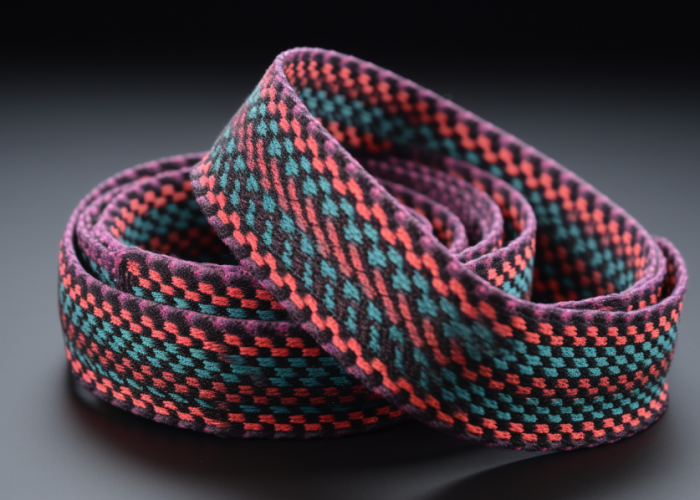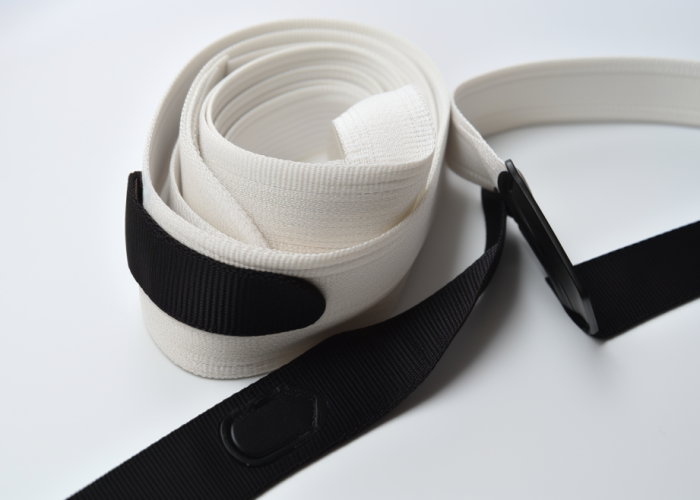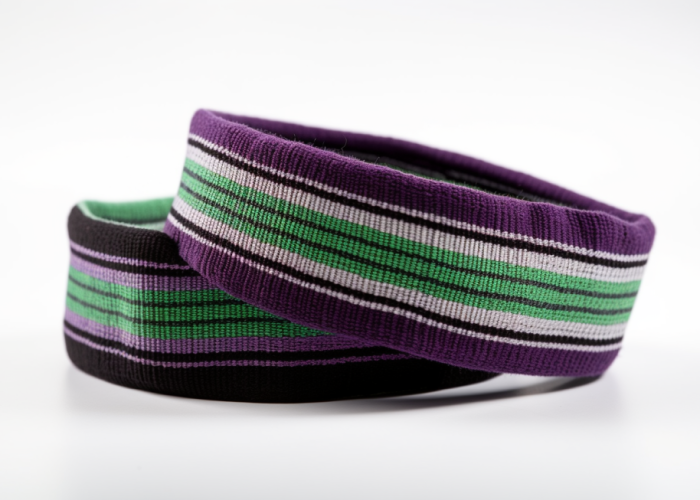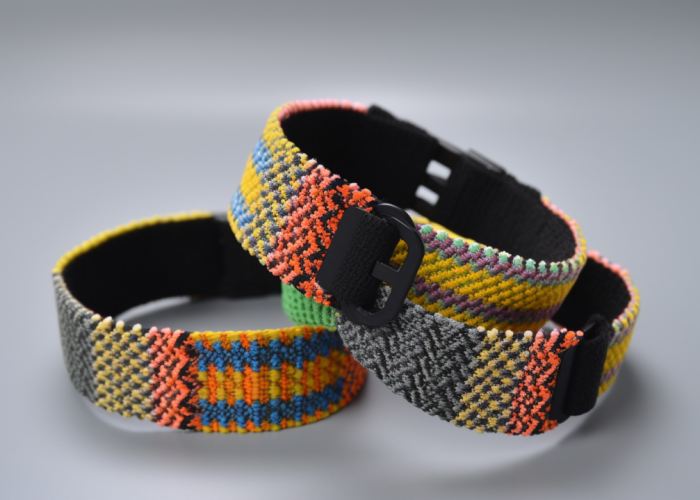As a custom webbing manufacturer, we often help product developers who struggle to achieve professional logo integration without compromising strap performance. Many engineers face the challenge of balancing aesthetic branding with functional elasticity—especially when standard elastic fails to meet both requirements. This guide addresses these design challenges and explains how jacquard spandex elastic straps provide tailor-made solutions for optimal product performance.
Jacquard spandex elastic straps are high-stretch woven bands with integrated logos or patterns, combining up to 500% elasticity with enhanced durability and visual customization.
Explore if jacquard spandex straps fit your needs with expert insights on specs, cost, and customization to guide your design decisions.


Webbing manufacturing expert with 15+ years of experience helping product developers build high-performance straps for industrial, medical, and outdoor use.
Jacquard spandex straps are highly suitable for apparel applications, particularly excelling in waistbands, athletic wear, and decorative accents where both elasticity and visual appeal are critical. Their smooth, non-irritating surface and integrated branding capabilities make them ideal for intimate apparel, activewear, and fashion accessories.
Key Apparel Applications:
From our manufacturing experience, these straps deliver 300-500% elongation with 98% recovery in demanding apparel environments. We’ve produced waistbands for premium lingerie brands where customers reported superior comfort and durability compared to standard elastic. Athletic wear applications show excellent performance with 200-300% stretch for compression while maintaining breathability—critical for sportswear performance.
The woven pattern structure eliminates delamination issues we’ve seen with applied logos on standard elastic. In high-end fashion projects, clients achieve intricate branding with up to 200 needles/inch resolution that plain elastic cannot match. These straps maintain colorfastness after 50+ wash cycles and meet skin-contact safety requirements.
Design Takeaway: For apparel requiring both functional elasticity and integrated branding, specify 15-25% spandex content for waistbands, 10-20% for decorative applications, and 20-50mm widths for optimal comfort and visual impact.
Jacquard spandex straps deliver superior performance advantages over plain elastic, including 80% higher abrasion resistance, integrated branding durability, and enhanced tensile strength up to 6,000N. These technical improvements translate directly to longer product lifecycles and reduced warranty claims.
Key Performance Advantages:
Testing data shows jacquard spandex straps withstand 50,000+ Martindale cycles before showing wear signs, compared to 28,000 cycles for comparable plain elastic. This 80% improvement stems from the jacquard weaving process creating a more robust fiber structure. Tensile strength reaches up to 6,000N in wider configurations, providing reliable load-bearing capacity for demanding applications like bag straps and safety equipment.
The integrated pattern approach eliminates the primary failure mode of applied graphics—delamination. Unlike screen-printed or heat-transferred logos that peel or crack over time, jacquard patterns are structurally woven into the fabric. This design approach ensures brand visibility remains consistent throughout the product’s service life, reducing customer complaints about logo degradation.
Material science principles show that the controlled fiber interlacing in jacquard weaving creates stress distribution advantages over plain weave structures, explaining the enhanced durability characteristics.
Design Takeaway: When product longevity and brand presentation are priorities, jacquard spandex straps justify their premium through measurably superior performance metrics and eliminate graphic failure modes.

Select jacquard spandex strap specifications based on your application’s stretch requirements, load demands, and width constraints. Match spandex content (10-30%) to desired elasticity, width (10mm-200mm) to load distribution needs, and pattern complexity to budget considerations.
Specification Selection Framework:
From manufacturing hundreds of custom projects, we’ve learned that elasticity requirements drive initial specification decisions. Waistband applications typically need 20-25% spandex content for comfortable stretch without over-extension, while athletic compression garments may require 25-30% for therapeutic pressure levels. Decorative applications often work well with 10-15% spandex, providing subtle flexibility without compromising pattern definition.
Width selection directly impacts load distribution and comfort. We’ve found 25-50mm widths optimal for functional applications like bag straps, providing adequate surface area for load spreading while maintaining reasonable material costs. Narrower widths (10-25mm) work well for decorative trim applications where visual impact matters more than load capacity.
Pattern complexity affects both cost and minimum order quantities. Simple geometric patterns require shorter setup times, while intricate logos or gradients increase production complexity and associated costs.
Design Takeaway: Start with your primary functional requirement—stretch, load, or appearance—then optimize other specifications around that priority. Request samples with different spandex contents to validate performance before committing to production quantities.
Jacquard spandex straps can be customized with high-resolution patterns, Pantone-matched colors, and raised textures for standout branding. Advanced looms support up to 200 needles per inch, metallic yarns, and gradient effects—allowing precise brand alignment and product differentiation across fashion, sports, and medical applications.
Customization Capabilities:
The jacquard weaving process allows complex pattern creation that would be impossible with traditional elastic manufacturing. Computer-controlled looms can achieve floral motifs, geometric designs, or precise logo reproduction with structural integration into the fabric during weaving, ensuring patterns won’t crack, peel, or fade over time.
Color matching capabilities extend beyond standard options through our digital yarn dyeing process. We can achieve precise Pantone specifications and create sophisticated gradients or multi-color transitions within single straps. Metallic threads add premium appearance for luxury applications, while raised texture effects create distinctive tactile elements that enhance brand recognition through touch.
Technical limitations include pattern size constraints and minimum thread count requirements for fine details. Complex patterns may require design modifications to maintain clarity, and very fine details need adequate yarn thickness to weave properly.
Design Takeaway: Provide vector artwork at actual size for pattern evaluation, specify Pantone colors for accurate matching, and consider design simplification for intricate logos to ensure optimal pattern clarity and manufacturing feasibility.

Jacquard spandex straps typically cost $0.10-$0.50 per meter, representing a 100-150% premium over plain elastic straps ($0.05-$0.20/meter). Pricing depends on pattern complexity, spandex content, and order quantities, with custom patterns requiring minimum orders to offset setup costs.
Cost Structure Factors:
The premium pricing reflects specialized manufacturing requirements and enhanced performance characteristics. Custom pattern setup involves programming computer-controlled looms and quality validation processes that don’t exist in plain elastic production. However, this investment delivers value through integrated branding that eliminates secondary decoration processes and associated labor costs.
Volume economics favor larger orders due to setup cost distribution. Orders under 1,000 meters carry higher per-meter costs, while orders exceeding 5,000 meters achieve optimal pricing efficiency. Pattern complexity significantly impacts cost—simple geometric patterns add approximately 20% to base pricing, while detailed logos can increase costs by 50-100%.
Material composition affects pricing through spandex content variations. Higher elasticity requirements (25-30% spandex) cost more than moderate stretch applications (15-20% spandex) due to premium fiber costs.
Design Takeaway: Budget $0.25-$0.35/meter for moderate complexity patterns, plan minimum 1,000-meter orders for cost efficiency, and consider simplified designs to optimize cost-performance balance for budget-sensitive applications.
Jacquard spandex straps meet comprehensive safety and quality standards, including OEKO-TEX Standard 100 for textile safety, REACH compliance for chemical restrictions, and medical device regulations when specified for healthcare applications. These certifications ensure product safety across diverse industries and international markets.
Safety Standards Compliance:
OEKO-TEX Standard 100 certification validates that jacquard spandex straps are free from harmful substances and safe for direct skin contact applications. This testing covers over 100 substances including formaldehyde, heavy metals, and restricted dyes. For medical applications like compression garments and orthopedic braces, additional biocompatibility testing under ISO 10993 ensures materials meet stringent healthcare requirements.
REACH compliance addresses chemical safety throughout the supply chain, particularly important for European markets. The regulation covers spandex fibers, dyes, and finishing treatments used in jacquard production. Colorfastness testing under ISO 105 standards ensures patterns maintain appearance integrity through washing, perspiration, and light exposure—critical for applications where safety markings or identification patterns must remain visible.
Quality management systems including ISO 9001 govern production processes, ensuring consistent manufacturing standards and traceability for regulatory compliance. Documentation packages support product certification requirements across different markets and applications.
Design Takeaway: Request certification documentation for your target markets, specify medical-grade materials for healthcare applications, and ensure pattern dyes meet colorfastness requirements for safety-critical applications where visibility is essential.

Sustainable jacquard spandex straps are available through recycled polyester (rPET) bases and bio-based spandex alternatives, reducing carbon footprint by up to 30% compared to virgin materials. These eco-friendly options maintain equivalent performance while supporting environmental responsibility goals and green product certifications.
Sustainability Options:
rPET integration utilizes recycled plastic bottles converted into high-performance polyester fibers, maintaining tensile strength and durability characteristics equivalent to virgin materials. This approach diverts waste from landfills while reducing energy consumption in fiber production. Bio-based spandex alternatives derived from plant sources offer similar elasticity properties while decreasing reliance on petroleum-based chemicals.
Manufacturing processes incorporate water-efficient dyeing techniques and energy-optimized equipment to minimize environmental impact. Improved fiber construction reduces microfiber shedding during washing cycles, addressing ocean pollution concerns. These environmental improvements don’t compromise performance—sustainable options deliver the same 300-500% elasticity and durability standards as conventional materials.
However, sustainable options may involve longer lead times and premium pricing due to specialized supply chains.
Design Takeaway: Sustainable jacquard spandex straps support environmental goals without performance compromise, ideal for brands prioritizing sustainability credentials, though expect 10-15% cost premiums and extended lead times for eco-friendly material sourcing.
Jacquard spandex straps deliver superior performance, integrated branding, and customizable specifications that plain elastic cannot match. For applications requiring both functional elasticity and professional appearance, these straps provide optimal material solutions. Contact us to explore custom jacquard spandex strap manufacturing solutions tailored to your product requirements.
All jacquard spandex straps include tensile strength certification, colorfastness testing reports, and dimensional accuracy verification. We guarantee pattern registration within ±1mm tolerance and provide replacement for any manufacturing defects.
Yes, we provide precise Pantone color matching and can match physical samples through spectrophotometer analysis. We’ll send color swatches for approval before production to ensure brand consistency across your product line.
We provide 1-meter samples for pattern validation and material testing at $25-50 per sample depending on complexity. Samples typically ship within 5-7 business days and sample costs are credited toward production orders over 2,000 meters.
We accept vector files (AI, EPS, PDF) at actual size with minimum 300 DPI resolution. Provide Pantone color specifications for accurate matching, and avoid fine details smaller than 2mm for optimal weaving clarity.
Yes, we ship worldwide with full customs documentation, HS codes, and origin certificates. Shipping typically takes 7-14 days internationally with tracking provided. We handle all export paperwork to streamline your import process.
Machine wash in cold water (30°C max), avoid bleach and fabric softeners, and air dry to maintain elasticity. The jacquard patterns are colorfast through standard industrial washing processes used in garment manufacturing.